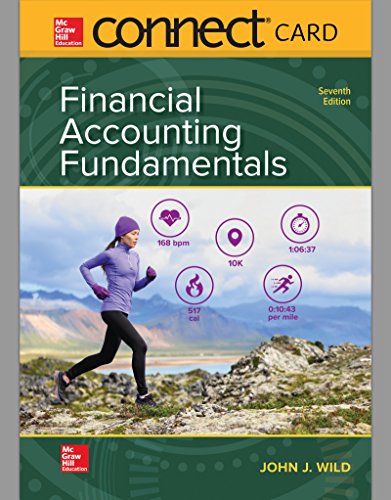
1.
Compute the time interest earned for Company E.
2.
Compute the time interest earned for Company S.
3.
Identify the effect of increase in sales by 10%, on each company’s net income.
4.
Identify the effect of increase in sales by 40%, on each company’s net income.
5.
Identify the effect of increase in sales by 90%, on each company’s net income.
6.
Identify the effect of decreases in sales by 20%, on each company’s net income.
7.
Identify the effect of decreases in sales by 50%, on each company’s net income.
8.
Identify the effect of decreases in sales by 80%, on each company’s net income.
9.
Comment on the results from requirement 3 through 8 in relation to the fixed-cost strategies of the two companies and the ratio values computed under requirement 1 and 2.
Want to see the full answer?
Check out a sample textbook solution
Chapter 9 Solutions
Connect Access Card For Financial Accounting Fundamentals
- Vertex Industries bases its manufacturing overhead budget on budgeted direct labor-hours. The direct labor budget indicates that 8,200 direct labor-hours will be required in August. The variable overhead rate is $6.40 per direct labor-hour. The company's budgeted fixed manufacturing overhead is $145,000 per month, which includes depreciation of $13,500. All other fixed manufacturing overhead costs represent current cash flows. What should be the August cash disbursements for manufacturing overhead on the manufacturing overhead budget? Need helparrow_forwardCan you explain this general accounting question using accurate calculation methods?arrow_forward?!arrow_forward
- Please provide the solution to this financial accounting question using proper accounting principles.arrow_forwardPlease explain the solution to this general accounting problem with accurate explanations.arrow_forwardDecker Processing Inc. placed 230,000gallons of direct materials into the refining process. At the end of the month, 12,500 gallons were still in process, 30% converted as to labor and factory overhead. All direct materials are placed in refining at the beginning of the process and conversion costs occur evenly during the process. Decker uses weighted-average costing. Determine the equivalent units in process for direct materials, assuming that 18,500 gallons were 30% complete prior to the addition of the 230,000 gallons.arrow_forward
- ??!!arrow_forwardWhat is the gross profit margin?arrow_forwardA company currently has $78 million in sales, $36 million in current assets, $62 million in fixed assets, and $24 million in accounts payable. The fixed assets are currently operated with full capacity and will change proportionally with the sales growth. Sales are projected to be $105 million, current assets are projected to be $45.3 million, and accounts payable are projected to be $29.5 million. What are fixed assets projected to be, given this information? Provide Accurate Answerarrow_forward

 AccountingAccountingISBN:9781337272094Author:WARREN, Carl S., Reeve, James M., Duchac, Jonathan E.Publisher:Cengage Learning,
AccountingAccountingISBN:9781337272094Author:WARREN, Carl S., Reeve, James M., Duchac, Jonathan E.Publisher:Cengage Learning, Accounting Information SystemsAccountingISBN:9781337619202Author:Hall, James A.Publisher:Cengage Learning,
Accounting Information SystemsAccountingISBN:9781337619202Author:Hall, James A.Publisher:Cengage Learning, Horngren's Cost Accounting: A Managerial Emphasis...AccountingISBN:9780134475585Author:Srikant M. Datar, Madhav V. RajanPublisher:PEARSON
Horngren's Cost Accounting: A Managerial Emphasis...AccountingISBN:9780134475585Author:Srikant M. Datar, Madhav V. RajanPublisher:PEARSON Intermediate AccountingAccountingISBN:9781259722660Author:J. David Spiceland, Mark W. Nelson, Wayne M ThomasPublisher:McGraw-Hill Education
Intermediate AccountingAccountingISBN:9781259722660Author:J. David Spiceland, Mark W. Nelson, Wayne M ThomasPublisher:McGraw-Hill Education Financial and Managerial AccountingAccountingISBN:9781259726705Author:John J Wild, Ken W. Shaw, Barbara Chiappetta Fundamental Accounting PrinciplesPublisher:McGraw-Hill Education
Financial and Managerial AccountingAccountingISBN:9781259726705Author:John J Wild, Ken W. Shaw, Barbara Chiappetta Fundamental Accounting PrinciplesPublisher:McGraw-Hill Education





